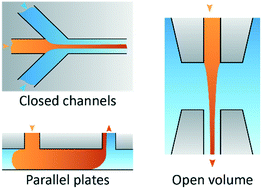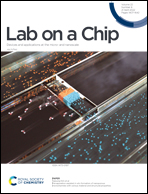Microscale hydrodynamic confinements: shaping liquids across length scales as a toolbox in life sciences†
Abstract
Hydrodynamic phenomena can be leveraged to confine a range of biological and chemical species without needing physical walls. In this review, we list methods for the generation and manipulation of microfluidic hydrodynamic confinements in free-flowing liquids and near surfaces, and elucidate the associated underlying theory and discuss their utility in the emerging area of open space microfluidics applied to life-sciences. Microscale hydrodynamic confinements are already starting to transform approaches in fundamental and applied life-sciences research from precise separation and sorting of individual cells, allowing localized bio-printing to multiplexing for clinical diagnosis. Through the choice of specific flow regimes and geometrical boundary conditions, hydrodynamic confinements can confine species across different length scales from small molecules to large cells, and thus be applied to a wide range of functionalities. We here provide practical examples and implementations for the formation of these confinements in different boundary conditions – within closed channels, in between parallel plates and in an open liquid volume. Further, to enable non-microfluidics researchers to apply hydrodynamic flow confinements in their work, we provide simplified instructions pertaining to their design and modelling, as well as to the formation of hydrodynamic flow confinements in the form of step-by-step tutorials and analytical toolbox software. This review is written with the idea to lower the barrier towards the use of hydrodynamic flow confinements in life sciences research.

- This article is part of the themed collection: Lab on a Chip HOT Articles 2022


 Please wait while we load your content...
Please wait while we load your content...